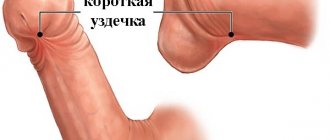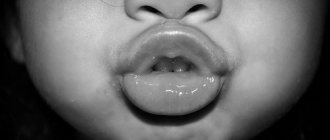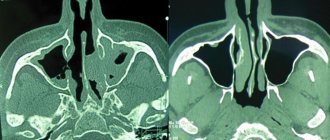Quick transition Treatment of a short frenulum of the tongue
A short frenulum of the tongue (ankyloglossia) is one of the most common minor anomalies in the development of the oral cavity.
The frenulum of the tongue is a fold of the oral mucosa that runs along the midline and connects the floor of the mouth with the lower surface of the tongue.
The function of the tongue frenulum is to fix the tongue to the soft tissues of the oral cavity, preventing tongue retraction (glossoptosis), especially during the neonatal period.
Symptoms
When crying, the tip of the baby's tongue bifurcates in the shape of a stylized heart.
The baby cannot stick his tongue out of his mouth. To test this reflex, you can run your finger over the baby's lips. Normally, the baby sticks his tongue out quite far, moving it around his lips in search of mother's milk.
Breastfeeding takes a lot of time, the baby is capricious, nervous, and clicking sounds are heard when sucking.
The baby is not gaining weight well.
A child with a short frenulum cannot reach the palate with his tongue.
There is a noticeable disturbance in the pronunciation of certain sounds during speech formation.
With a short frenulum (less than 1.5 cm), if it is attached to the soft tissues of the floor of the mouth, functional disorders do not always occur. These include difficulty sucking during breastfeeding and disturbances in sound pronunciation during the formation of phrasal speech.
After operation
As a rule, there are no complications after trimming the frenulum of the upper, lower lip or tongue, and recovery takes only a few days. When the operation is performed, it is best to feed the baby immediately, since mother's milk acts as a pain reliever. Adult patients should temporarily avoid hard and sticky foods. If there are problems with speech, then special sessions with a speech therapist are necessary. The slight discomfort caused by the sutures will go away on its own after they are absorbed, that is, after 4-5 days, maximum in a couple of weeks.
Consequences of frenulum anomaly
Hypotrophy due to impaired sucking, poor weight gain in infants.
Malocclusion, the first signs of which during the period of temporary occlusion is the rotation of the central lower incisors to the lingual side.
Impaired development of the lower jaw, as a result, the formation of a distal bite.
Local gingivitis, periodontitis up to exposure of the roots of the teeth in the area of the lower jaw incisors.
Violation of the pronunciation of sounds that require raising the tongue upward: “sh”, “zh”, “sch”.
Impaired language development due to asymmetrical growth. Low mobility of the tongue impairs the articulation of some sounds. Violation of diction (clarity, intelligibility of pronunciation).
When is tongue frenulum trimming required?
The frenulum of the tongue is a small elastic membrane connecting the tongue to the oral cavity. The frenulum is responsible for important functions of the tongue: movement, breathing, swallowing, speech. This disorder is called ankylogloxia.
The normal development of the lingual frenulum begins centrally, at the root of the tongue, and ends at the lower incisors. The rest of the arrangement is a deviation. There are several deviations in the development of the frenulum:
- Short bridle. The tongue becomes inactive and leads to improperly formed speech and jaw deformation.
- Incorrectly positioned frenulum. Reduces motor activity of the tongue.
- Long frenulum under the tongue. It can be located at the tip of the tongue and affect the swallowing process, disrupting nutrition.
Problems with the development of the tongue frenulum are a congenital pathology. And it is hereditary in nature. May occur due to problems during pregnancy.
Trimming the frenulum for an adult
The operation to trim the frenulum of the tongue can be performed at any age as prescribed by a doctor.
Every 20th person has a shortened frenulum of the tongue. The likelihood of this anomaly occurring in men is much higher than in women.
To independently check how the frenulum is located under the tongue, you can do simple children’s exercises: “horse”, “mushroom”, “painter”. Externally, the frenulum will not differ from a healthy state. If you experience any discomfort while performing these exercises, you should go to the clinic for a consultation.
Symptoms that will help you identify problems with tongue webbing:
- When the tongue is extended, the tip of the tongue bends down;
- Difficulty swallowing;
- It is not possible to insert the tongue completely;
- Bite problems;
- Inflammation of the surrounding tissues of the tooth;
- When the tongue is raised, it takes the shape of a heart;
- Incorrect pronunciation of words.
Adults require frenulum trimming less often than small children. However, tissue healing in an adult takes a little longer than in small children. This type of operation is performed under local anesthesia.
When is surgery scheduled?
The frenulum circumcision operation is performed for the following indications:
- Impaired pronunciation of words. If the speech therapist did not notice the deviation in childhood, then speech defects may occur in adulthood. The operation will help restore the functioning of the speech apparatus.
- Orthodontist recommendations. A frenulum that is too short causes crooked teeth and stunts the growth of the lower jaw.
- Periodontal recommendations. Due to deformation of the gums, the root of the tooth is exposed, which makes it susceptible to other diseases.
When not to have surgery
Since all surgical procedures have limitations. If you have:
- acute chronic diseases of the oral cavity;
- benign tumors of the jaw tissue;
- infectious diseases of the whole body;
- poor blood clotting;
- mental disorder;
The operation to trim the frenulum of the tongue is called frenuloplasty.
Types of frenuloplasty
This type of operation can be performed in 3 ways:
- Cutting. The bridle is trimmed, the edges of which are sewn with transverse seams.
- Delete. The frenulum is trimmed using two triangular incisions and removed, after which sutures are applied.
- Moving. The edge of the frenulum is trimmed and secured in the required place with sutures.
The entire operation takes no more than 20 minutes. After a few days, the stitches will dissolve on their own. There are no complications after frenuloplasty.
Causes of the defect
A short frenulum of the tongue in a newborn is a congenital anomaly
, which is formed in the first months of fetal development, when all organs are formed. There are several reasons for its appearance:
- The presence of a hereditary predisposition: if the parents had such a feature, it can be inherited.
- The older the expectant mother, the more likely her child is to develop a short frenulum due to the increased risk of developing anomalies.
- The defect can develop if a woman has an infection during pregnancy or suffers from chronic diseases.
- Severe early toxicosis can lead to a lack of nutrients, which is why the fetal organs do not form correctly.
- Exposure to any teratogenic factors: radiation, toxic substances, drugs that are harmful to the body, alcohol, tobacco and drugs.
- Accidents involving injuries to pregnant women.
Some of these reasons do not depend on the actions of future parents, especially genetic predisposition. Other risk factors should be avoided: a pregnant woman should not work in hazardous work, drink, smoke, self-medicate, or expose herself to the risk of falls when playing sports.
Frenum of the upper and lower lips
In the human oral cavity there are 2 more folds of skin. They serve as an additional attachment of the lips to the jaws.
The frenulum of the upper lip is a fold located vertically. According to its structure, it is of the following types:
- Mucous. Outwardly, it resembles a thin film that stretches very well.
- Fibrous. The fold is very tight and practically does not stretch.
- Muco-fibrous. In this case, they speak of an average degree of density and extensibility of the upper frenulum.
In addition, it is classified by attachment height:
- Low. The fold passes directly into the gingival papilla.
- Average. Located in the middle of the gum.
- High. It is located in the transitional fold of the upper lip.
It is considered normal if the lower connection of the lip frenulum is located at a distance of approximately 5 mm from the neck of the anterior incisors. If it is located lower or even goes behind the teeth, then the fold is considered shortened.
The lower frenulum is located deep in the area between the gum and the inside of the lip. Normally, it is a thin, barely noticeable film. Its difference from the frenulum of the upper lip is also that it should not be attached to the gingival papilla. Otherwise, correction of the fold is indicated to avoid the appearance of speech defects. As a rule, its abnormal location is detected soon after birth. The correction is carried out surgically, after which the film does not affect the development of the child’s speech in any way.
Examinations before surgery and contraindications
Any surgical procedure in the oral cavity is a risk to the body. In order to prevent complications after surgery, it is necessary to undergo preliminary examinations prescribed by the doctor. The most significant tests are blood and urine tests, determination of blood coagulation and fluorography.
Contraindications for frenuloplasty are infections of the throat, oral cavity, inflammatory processes in any part of the body
, since pathogenic microorganisms can enter the incision of the mucous membrane. This is why a mandatory examination is carried out before intervention. You cannot operate on patients with cancer or decreased blood clotting.
Which doctor should I contact?
If you are concerned about the location of the folds in your mouth, you should make an appointment with your dentist or surgeon. In most cases, they can trim the bridle the same day.
If the fold is torn or there are abnormalities in its development on the penis, you should contact a urologist.
results
The main goal of tongue frenuloplasty is to prevent tongue dysfunction that occurs subsequently. If you do not trim the folds of mucous membrane, then in the future the child may have difficulties with eating, diction and lip movements.
Don't be afraid of surgery. This is a simple procedure that takes a few minutes, and the cutting of the short frenulum itself takes place in a few seconds. Since the mucous membrane in children is still too thin, the child does not feel pain. Minor bleeding goes away quickly and does not pose any danger.
The help of a qualified dentist is an absolute guarantee of high-quality results and the absence of complications.
Features of the procedure
Plastic surgery of the frenulum of the tongue involves cutting it with a scalpel or surgical scissors. After cutting the fold of the mucous membrane in a newborn, the tissue immediately stretches and lengthens after healing. When the operation is performed at the age of 3–5 years, the process of stretching the frenulum is more complex. To increase the length of the fold and prevent the formation of scars, the child will need to perform special exercises.
In Martinka dentistry, plastic surgery of the frenulum of the tongue and lip is performed not only by the classical, but also by the modern method using a laser. The use of laser equipment eliminates the risk of infection and bleeding. The laser has an antiseptic effect and instantly seals the vessels; moreover, during the operation there is no contact of the instrument with the tissues of the oral cavity. Laser surgery involves contraindications and is only allowed for children over 1 year of age.
For newborn children, tongue frenuloplasty can be performed without anesthesia. In children from 3 months of age, the folds of the mucous membrane thicken, which suggests discomfort and minor pain during the operation, so cutting the frenulum is done with local anesthesia. Sedation is used only in extreme cases, if the child has complex illnesses or increased anxiety.
Foreskin
The frenulum of the foreskin is the most important element of the male penis. It ensures the normal functioning of the reproductive system, protecting the reproductive organ from pathogenic microorganisms and external influences. It has a high degree of elasticity, due to which during an erection the head of the penis is exposed, and when its blood supply decreases, it is covered by the foreskin.
Every man should know that the frenulum is a formation of skin, the developmental anomalies of which negatively affect both sexual life and health:
- every sexual intercourse becomes painful;
- ejaculation occurs prematurely;
- the penis gradually becomes curved.
Against the background of these disorders, almost every man develops psycho-emotional disorders.
From an anatomical point of view, the frenulum on the head of the penis is a fold that forms a kind of membrane that connects the lower part of the penis and the foreskin. It performs not only a protective function. The frenulum is also a powerful erogenous zone, which directly affects the duration of sexual intercourse and the sensations during ejaculation.
Inside the fold there is a huge number of vessels and nerve endings, due to which any injury or disease in this area is accompanied by pain and other unpleasant symptoms, as well as psychological discomfort. Ignoring warning signs can lead to serious consequences, and therefore you should consult a doctor the first time they appear.
Correction using gymnastics for the tongue
Only a doctor can determine whether it is worth performing surgery on a child’s short frenulum of the tongue or whether it is better to remove the defect with the help of exercises. Therefore, even if parents are not inclined to undergo surgery, they still need to go to a pediatrician or dentist for consultation and surgery or correct individual selection of exercises.
The opportunity to conduct gymnastic classes appears when the baby can already repeat some given actions. But there are simple exercises even for newborns: they are given a silver spoon to lick, milk is dripped onto their upper lip, which makes them try to lick it, and at a slightly older age they are smeared with jam.
When the baby is able to understand the mother’s requests to repeat certain actions, you can do more complex gymnastics:
- Close your mouth and feel the side walls of your tongue, palate and lower part of your mouth.
- Open your mouth and reach as far as possible to the outer surface of your lips.
- Click your tongue.
- Place the tongue on your lower lip and hold it in this position for 10 seconds.
- Stick your tongue out as far as possible and hold for 10 seconds. You can also ask the baby in a playful way to show how long his tongue is.
Postoperative period
The mucous membrane in the mouth is restored quickly. But cutting the frenulum can cause complications:
- Formation of a hard scar at the site where the incision was made.
- The development of the inflammatory process due to infection.
- Temperature increase. It appears as a sign of the development of an infectious process or a peculiar reaction to an operation.
The baby may react to complications with constant anxiety and refusal to eat. Children three years old and older can tell themselves what worries them. If you experience any discomfort, you should consult a doctor; only a specialist will correctly assess the baby’s condition and prescribe the best treatment.
To avoid complications, you need to keep your mouth clean. Five-year-old children already brush their teeth and can rinse their mouths with water. For several days after the defect is removed, you should not chew solid food or talk much.
You should ask your doctor exactly how long the restrictions should be observed. After a follow-up examination, the attending doctor will recommend special exercises to develop the elasticity of the frenulum.









